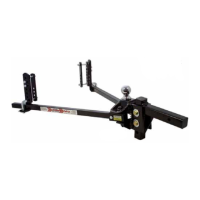20
www.equalizerhitch.com
Good adjustment:
You have most likely achieved good weight distribution adjustment
if your measurements show the following:
1.The FRONT of the tow vehicle measures the same as, or slightly
higher than its uncoupled height. (The “Front” column of Line C is the same
or slightly higher than line A).
2.The REAR of the tow vehicle is slightly lower than its uncoupled
height, but noticeably higher than it is when coupled without weight distri-
bution engaged. (The “Rear” column of Line C is between lines A and B,
but much closer to A. Line C is NEVER HIGHER than line A). See Figure
13 on page 17 and Figure 14 below.
Weight distribution is only one of many things that inuence sway. The
operator is responsible for making necessary adjustments to all contrib-
uting factors in order to minimize sway.
Under or Over Adjustment:
If the hitch is transferring too little or too much weight you must make
adjustments to the hitch setup. For changes during the initial setup we rec-
ommend adding or removing spacer washers rst to try and keep the spring
arms parallel with the trailer frame. In our experience, this can help reduce
the amount of noise the hitch makes during slow, tight turns. It also gives
you more adjustment options if needed later.
Once the maximum (8) or minimum (4) number of spacer washers has
been reached, further adjustments can be made by raising or lowering the L-
brackets. Minor adjustments later for changes in loading can usually be done
by moving only the L-brackets.
Over or under adjusted weight distribution decreases tow vehicle stability.
Figure 14

